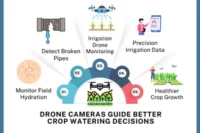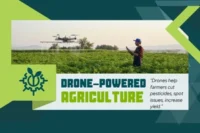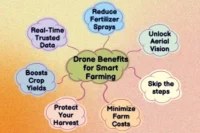Smarter Irrigation and Healthier Crops with Drone Cameras
Published: 7 Aug 2025
Wasting water? Not sure which part of your field needs it most? A drone camera for agricultural use can solve that. With aerial images, you can spot dry patches, overwatered areas, and broken pipes, without stepping into the field. Drones help monitor irrigation across wide farmland quickly and clearly. No more assumptions or overwatering. The data they provide helps farmers plan better and save water. It’s smart farming made simple. Whether you use drip, sprinkler, or flood irrigation, drone cameras give you the info you need to use water wisely and grow healthier crops.
Spot Dry Patches and Overwatered Areas
Drone cameras help farmers see things they might miss from the ground. By flying over the field, drones take clear pictures that show which areas are too dry or too wet. This helps farmers fix problems early and save water.
Field-Level View : Drone cameras fly low and take wide, clear shots of your crops. These images show patterns that are hard to see from the ground.
Dry Patch Signs : Dry spots often look pale, yellow, or thin in drone photos. These areas need more water or attention.
Wet Area Clues : Overwatered zones appear darker or muddy in the images. These can lead to root damage or wasted water.
Real-Life Fix : One farmer spotted dry rows on one side of his field. He adjusted the irrigation system right away and saved both water and crop health.
Detect Broken Pipes Without Entering the Field
Drone cameras help farmers find water leaks fast, without stepping into the field. A quick flight over your land can show signs of pipe damage that may go unnoticed from the ground.
Spot Leak Marks : Drones can capture wet spots, puddles, or soil discoloration that often point to broken pipes.
Save Time Daily : Instead of walking the whole field, farmers can use drones to scan everything in minutes.
Cover Hard Areas : For large, muddy, or uneven land, drones are safer and quicker than walking or driving through.
Fix Found Fast : One farmer noticed a soggy patch in a back corner through drone footage. A cracked pipe was leaking nonstop—fixed the same day.
Monitor Irrigation Across Large Farmland
On big farms, checking irrigation by foot takes too much time. Farm drones make it easier by showing the whole field from above in just a few minutes.
Bird’s-Eye View : Drones fly over your entire field and give you a full picture. You can see every part at once without moving an inch.
Quick Field Check : What used to take hours can now be done in minutes. Just launch the drone and start reviewing.
Compare Sections Easily : You can spot which areas are doing well and which ones look dry or too wet. It’s all visible from the drone footage.
Works with Any System : Whether you use drip lines, sprinklers, or flood irrigation, drones help track how water spreads across the field.
Provide Data for Better Water Planning
Cameras don’t just show pictures—they give useful data that helps farmers plan how and when to use water. This leads to smarter daily choices and long-term savings.
Clear Visual Data : Drones capture sharp images that show crop health, dry zones, and water flow. This helps you see what’s working and what’s not.
Thermal Heat Maps : Some drones use thermal sensors to spot hot, dry areas. These maps make it easy to find spots that need more water.
Daily Planning Help : You can decide where to water each day based on what the drone shows. No more guessing or wasting time.
Plan the Season : One farmer changed his watering schedule after noticing dry patches early in the season. That small change led to better crop growth and water savings.
Help Use Water Wisely for Healthier Crops
When crops get just the right amount of water, they grow stronger and give better results. Drone cameras help farmers water smarter, not more.
Boost Plant Health : Drones show which areas need water and which don’t. This helps crops grow evenly and stay healthy.
Lower Disease Risk : Overwatering can cause root rot and fungus. By avoiding wet spots, farmers reduce the chance of crop diseases.
Save More Money : Using less water means lower water bills. You also use fewer chemicals because healthy crops need less treatment.
Better Harvests : One farmer used drone data to fine-tune his watering. The result? More crops, better quality, and less waste.
Conclusion
Using a drone camera for agricultural use isn’t just about flying tech—it’s about farming smarter. With just a few flights, you can spot water problems early, fix broken pipes, monitor big fields fast, and plan better for each season. The result? Less water waste, stronger crops, and more savings.
Ready to see the difference on your own farm? Try a drone camera and take control of your irrigation.
FAQs
No. Most farming drones are made for beginners. With basic training, anyone can fly them and read the images.
You can fly it weekly or even daily, depending on your needs. Many farmers check before or after watering. Regular checks mean quicker fixes.
There are affordable options made just for farming. Some models cost less than a smartphone. You don’t need a fancy drone to get good results.





